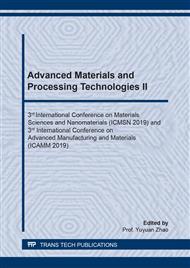[1]
J. Koehler, F.P. Brandl, and A.M. Goepferich. Hydrogel wound dressings for bioactive treatment of acute and chronic wounds. Eur. Polym. J. Vol. 100 (2018), p.1–11.
DOI: 10.1016/j.eurpolymj.2017.12.046
Google Scholar
[2]
S. Enoch, and D.J. Leaper. Basic science of wound healing. Surgery. Vol. 26 (2008), pp.31-37.
DOI: 10.1016/j.mpsur.2007.11.005
Google Scholar
[3]
J. Li, J. Chen, and Kirsner R. Pathophysiology of acute wound healing. Clin. Dermatol. Vol. 25 (2007), pp.9-18.
Google Scholar
[4]
J.L. Monaco, and W.T. Lawrence. Acute wound healing: and overview. Clin. Plast. Surg. Vol. 30 (2003), pp.1-12.
Google Scholar
[5]
A.J. Singer, and R.A. Clark. Cutaneous wound healing. N. Engl. J. Med. Vol. 341 (1999), pp.738-746.
Google Scholar
[6]
M.P. Rodero, and K. Khosrotehrani. Skin wound healing modulation by macrophages. Int. J. Clin. Exp. Pathol. Vol. 3 (2010), pp.643-653.
Google Scholar
[7]
N. Sahiner, S. Sagbas, and M. Sahiner, et al. Biocompatible and biodegradable poly(tannic acid) hydrogel with antimicrobial and antioxidant properties. Int. J. Biol. Macromol. Vol. 82 (2016), pp.150-159.
DOI: 10.1016/j.ijbiomac.2015.10.057
Google Scholar
[8]
M. Mostafa, K. Pradeep, and E.C. Yahya, et al. Artificial, Triple-Layered, Nanomembranous Wound Patch for Potential Diabetic Foot Ulcer Intervention. Materials. Vol. 11 (2018), pp.21-28.
DOI: 10.3390/ma11112128
Google Scholar
[9]
A.K. Tsirogianni, N.M. Moutsopoulos, and H.M. Moutsopoulos. Wound healing: immunological aspects. Injury. Vol. 37 (2006), p. S5-S22.
DOI: 10.1016/j.injury.2006.02.035
Google Scholar
[10]
A. Sood, M.S. Granick, and N.L. Tomaselli. Wound dressings and comparative effectiveness data. Adv. Wound Care. Vol. 8 (2014), pp.511-529.
DOI: 10.1089/wound.2012.0401
Google Scholar
[11]
S.N. Pawar, and K.J. Edgar. Alginate derivatization: a review of chemistry, properties and applications. Biomater. Vol. 33 (2012), p.3279–3305.
DOI: 10.1016/j.biomaterials.2012.01.007
Google Scholar
[12]
K. Azuma, R. Izumi, and T. Osaki, et al. Chitin, chitosan, and its derivatives for wound healing: old and new materials. J. Funct. Biomater. Vol. 6 (2015), p.104–142.
DOI: 10.3390/jfb9020038
Google Scholar
[13]
L.I. Moura, A.M. Dias, and E. Suesca, et al. Neurotensin-loaded collagen dressings reduce inflammation and improve wound healing in diabetic mice. Biochim. Biophys. Acta. Mol. Basis Dis. Vol. 1842 (2014), p.32–43.
DOI: 10.1016/j.bbadis.2013.10.009
Google Scholar
[14]
A. Fahmy, E.A. Kamoun, and R. El-Eisawy, et al. Poly(vinyl alcohol)-hyaluronic acid membranes for wound dressing applications: synthesis and in vitro bio-evaluations. J. Braz. Chem. Soc. Vol. 26 (2015), p.1466–1474.
DOI: 10.5935/0103-5053.20150115
Google Scholar
[15]
K.R. Kirker, Y. Luo, and J.H. Nielson, et al. Glycosaminoglycan hydrogel films as bio-interactive dressings for wound healing. Biomater. Vol. 23 (2002), p.3661–3671.
DOI: 10.1016/s0142-9612(02)00100-x
Google Scholar
[16]
J.R. Fraser, T.C. Laurent, and U.B. Laurent. Hyaluronan: its nature, distribution, functions and turnover. J. Intern. Med. Vol. 242 (1997), p.27–33.
DOI: 10.1046/j.1365-2796.1997.00170.x
Google Scholar
[17]
L.P.d. Silva, R.P. Pirraco, and T.C. Santos, et al. Neovascularization induced by the hyaluronic acid-based spongy-like hydrogels degradation products. ACS Appl. Mater. Interfaces. Vol. 49 (2016), p.33464–33474.
DOI: 10.1021/acsami.6b11684
Google Scholar
[18]
J.Y. Zhao, J.K. Chai, and H.F. Song, et al. Influence of hyaluronic acid on wound healing using composite porcine acellular dermal matrix grafts and autologous skin in rabbits. Int. Wound J. Vol. 10 (2013), p.562–572.
DOI: 10.1111/j.1742-481x.2012.01023.x
Google Scholar
[19]
M.G. Neuman, R.M. Nanau, and L. Oruna-Sanchez, et al. Hyaluronic acid and wound healing. J. Pharm. Pharm. Sci. Vol. 18 (2015), p.53–60.
DOI: 10.18433/j3k89d
Google Scholar
[20]
T.V. Anilkumar, J. Muhamed, and A. Jose, et al. Advantages of hyaluronic acid as a component of fibrin sheet for care of acute wound. Biologicals. Vol. 39 (2011), p.81–88.
DOI: 10.1016/j.biologicals.2011.01.003
Google Scholar
[21]
X.Z. Shu, Y.C. Liu, and Y. Luo, et al. Disulfide Cross-Linked Hyaluronan Hydrogels. Biomacromolecules. Vol. 3 (2002), pp.1304-1311.
DOI: 10.1021/bm025603c
Google Scholar
[22]
Y. Yang, H.K. Zhu, and J. Wang, et al. Enzymatically Disulfide-Crosslinked Chitosan/ Hyaluronic Acid Layerby-Layer Self-Assembled Microcapsules for Redox-Responsive Controlled Release of Protein. ACS Appl. Mater. Interfaces. Vol. 10 (2018), p.33493−33506.
DOI: 10.1021/acsami.8b07120
Google Scholar
[23]
L. He, J.R. Yang, and J. Lu, et al. Preparation and characterization of a novel hyaluronic acid–icariin conjugate hydrogel. Materials Letters. Vol. 136 (2014), p.41–44.
DOI: 10.1016/j.matlet.2014.08.006
Google Scholar
[24]
S. Yu, Y.Y. Duan, and X.G. Zuo, et al. Mediating the invasion of smooth muscle cells into a cell-responsive hydrogel under the existence of immune cells. Biomater. Vol. 180 (2018), pp.193-205.
DOI: 10.1016/j.biomaterials.2018.07.022
Google Scholar
[25]
M.M. He, J.H. Sui, and Y.F. Chen, et al. Localized multidrug co-delivery by injectable self-crosslinking hydrogel for synergistic combinational chemotherapy. J. Mater. Chem. B. Vol. 5 (2017), pp.4852-4862.
DOI: 10.1039/c7tb01026e
Google Scholar
[26]
S.J. Huang, C.F. Wang, and J.W. Xu, et al. In situ assembly of fibrinogen/hyaluronic acid hydrogel via knob-hole interaction for 3D cellular engineering. Bioactive Materials. Vol. 2 (2017), pp.253-259.
DOI: 10.1016/j.bioactmat.2017.09.002
Google Scholar
[27]
Y.C. Liu, X.Z. Shu, and D.P. Glenn. Biocompatibility and stability of disulfide-crosslinked hyaluronan films. Biomater. Vol. 26 (2005), p.4737–4746.
DOI: 10.1016/j.biomaterials.2005.01.003
Google Scholar
[28]
C.G. Williams, A.N. Malik, and T.K. Kim, et al. Variable cytocompatibility of six cell lines with photoinitiators used for polymerizing hydrogels and cell encapsulation. Biomater. Vol. 26 (2005), p.1211–1218.
DOI: 10.1016/j.biomaterials.2004.04.024
Google Scholar
[29]
N. Broguiere, L. Isenmann, and M.Z. Wong. Novel enzymatically cross-linked hyaluronan hydrogels support the formation of 3D neuronal networks. Biomater. Vol. 99 (2016), pp.47-55.
DOI: 10.1016/j.biomaterials.2016.04.036
Google Scholar
[30]
S.J. Bryant, C.R. Nuttelman, and K.S. Anseth. Cytocompatibility of UV and visible light photoinitiating systems on cultured NIH/3T3 fibroblasts in vitro. J. Biomat. Sci. Polym. E. Polym. Ed. Vol. 11 (2012), pp.439-457.
DOI: 10.1163/156856200743805
Google Scholar
[31]
S.J. Huang, C.F. Wang, and J.W. Xu, et al. In situ assembly of fibrinogen/hyaluronic acid hydrogel via knob-hole interaction for 3D cellular engineering. Bioactive Materials. Vol. 2 (2017), pp.253-259.
DOI: 10.1016/j.bioactmat.2017.09.002
Google Scholar


